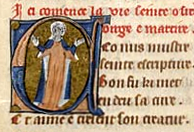Osgyth
Osyth | |
|---|---|
 An illuminated capital commencing the anonymous "La Vie seinte Osith, virge e martire" (Campsey Manuscript, British Library Additional Ms 70513, fol. 134v) | |
| Born | Quarrendon, Buckinghamshire |
| Died | 653 AD |
| Venerated in | Roman Catholic Church Anglican Communion |
| Feast | 7 October |
| Attributes | Depicted carrying her own head |
Osyth or Osith (died 653 AD) was an English saint. She is primarily commemorated in the village of Saint Osyth, Essex, near Colchester. Alternative spellings of her name include Sythe, Othith and Ositha.
Life
Born in Quarrendon, Buckinghamshire (at that time part of Mercia), she was the daughter of Frithwald, a sub-king of Mercia in Surrey, and was the niece of Saint Edith and Saint Edburga of Bicester. Her mother was Wilburga, the daughter of the pagan King Penda of Mercia.
Raised in a convent in Warwickshire under the direction of Saint Modwen her ambition was to become an abbess, but she was too important as a dynastic pawn to be set aside.
Forced by her father into a dynastic marriage with King Sighere of Essex, she did her dynastic duty and produced him a son. While her husband ran off to hunt down a beautiful white stag, Osyth persuaded two local bishops to accept her vows as a nun. Then, eventually, perhaps after Sighere's death, she established a convent at Chich, in Essex, where she ruled as first abbess.
She was murdered by Danish Viking marauders in 653.
Her death was accounted a martyrdom by some, but Bede makes no mention of Saint Osyth. The 13th-century chronicler Matthew Paris repeats some of the legend that had accrued around her name. The site of her martyrdom became transferred to the holy spring at Quarrendon. The holy spring at Quarrendon, mentioned in the time of Osyth's aunts, now became associated with her legend, in which Osyth stood up after her execution, picking up her head like Saint Denis in Paris, and other cephalophoric martyrs and walking with it in her hands, to the door of a local convent, before collapsing there.
Veneration
Later, Chich (Osyth) was assumed as part of his royal demesne by the Dane King Canute, who granted it to Earl Godwin, and by him it was given to Christ Church, Canterbury. At the Conquest it was transferred to the Bishopric of London.
On the site of the former nunnery, Richard de Belmeis of London, in the reign of Henry I founded a priory for canons of Saint Augustine, and his remains were buried in the chancel of the church in 1127: he bequeathed the church and tithes to the canons, who elected as their first abbot or prior William de Corbeil, afterwards Archbishop of Canterbury (died in 1136).
His benefactions, charters and privileges granted by Henry II, made the Canons wealthy: at the Dissolution of the monasteries in 1536, its revenues were valued at £758 5s. 8d. yearly. A gatehouse and so-called 'Abbot's Tower' and some ranges of buildings remain.
Osyth's burial site at Saint Mary's Church in Aylesbury was a site of great pilgrimage. However, following a papal decree in 1500, the bones were removed from the church and buried in secret. The Catholic Encyclopedia gave Saint Osyth no mention. Undeterred, according to the 17th century curious antiquary John Aubrey (author of the Brief Lives) "in those days, when they went to bed they did rake up the fire, and make a X on the ashes, and pray to God and Saint Sythe[1] to deliver them from fire, and from water, and from all misadventure." A house in Aylesbury is still called Saint Osyth's House in her honour.
Her feast day is 7 October. She is normally depicted carrying her own head.
References
- ^ That is, Saint Osyth.
External links
- St. Osyth, Essex: Official Site: "About St. Osyth" has some historical detail
- Picturesque England: St. Osyth's priory, with details of her legend (text)
- Encyclopaedia Britannia "Lives"
- St Osyth's Spring Animated and Narrated Edition of the St Osyth Story
- Alban Butler, Lives of the Saints.
